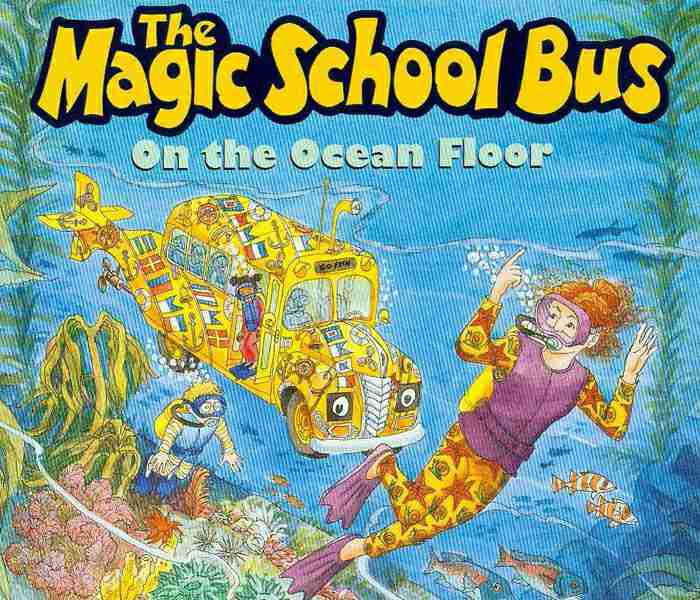
The Magic School Bus on the Ocean Floor
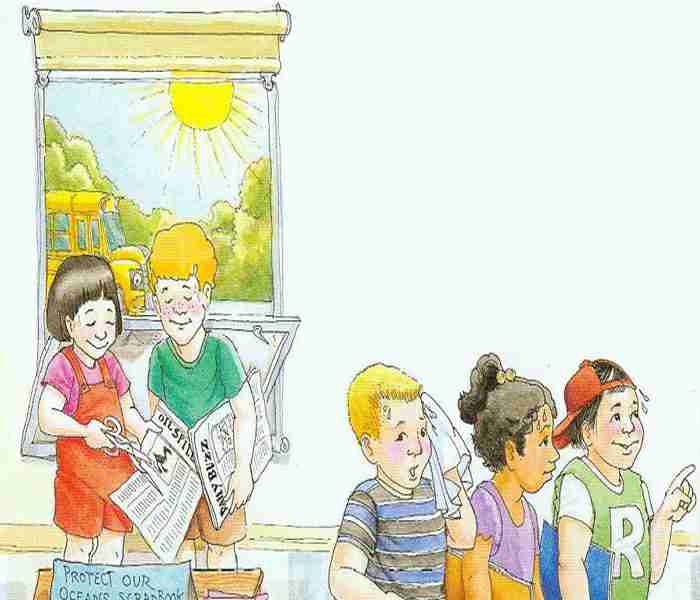
It was the end of the day, and it was hot in school.
We had been working for hours on our ocean science projects.
All our work made Ms. Frizzle very happy. But it made us very tired and hot.
Wow. It's hot today. Nor Ms. Frizzle's dress. Yeah, it's cool man.

Doesn't learning about oceans make you happy, Arnold?
Actually, it makes me feel kind of crabby.
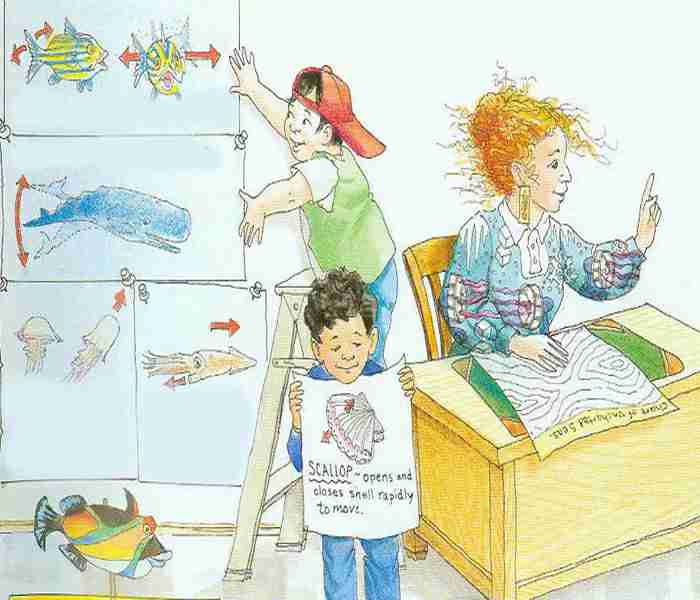
We were putting the finishing touches on a display about how ocean animals swimwhen someone said, "I wish we could go swimming."

Ms. Frizzle looked up. Without warning, she said.
"As a matter of fact, children, I've been planning a class trip to the ocean for tomorrow."
Everybody cheered. Sometimes having a weird teacher isn't so bad!
Did she say ocean? Where we can swim and play?Is she serious? Don't ask, just pack your beach bag!
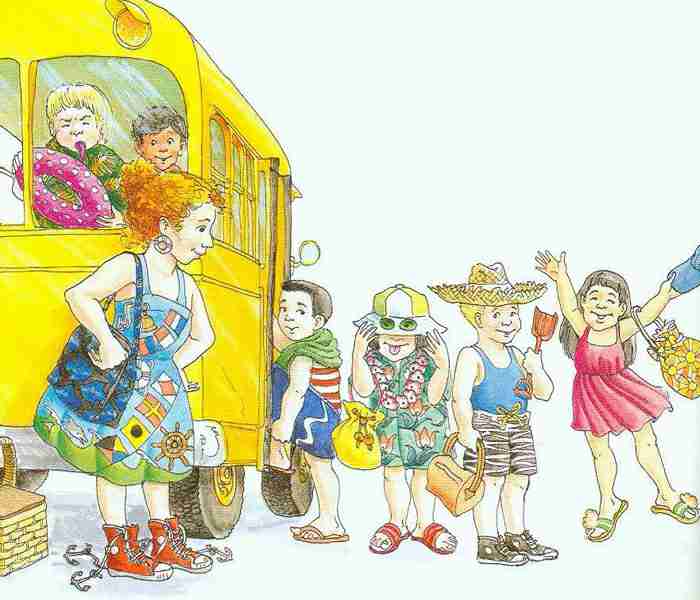
The next day, everyone showed up in a bathing suit.We boarded the old school bus, and Frizzie started the engine.
We were ready for a day of fun in the sun!
I can't wait to go swimming! I'm going to build a sand castle. Boy, are we lucky!
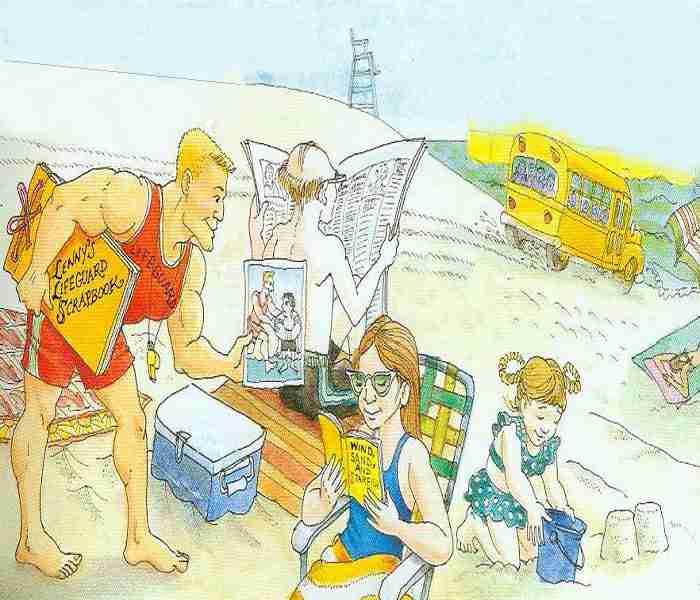
When we finally came to the beach, we wanted to jump off the bus.
But guess what? Ms. Frizzle didn't stop.
She kept right on going - past the lifeguard station, across the sand, and down to the water's edge.
Hi I'm Lenny the lifeguard. Here's a picture of me saving a third-grader last summer.
Hey, where are we going? Isn't she supposed to park in the parking lot?
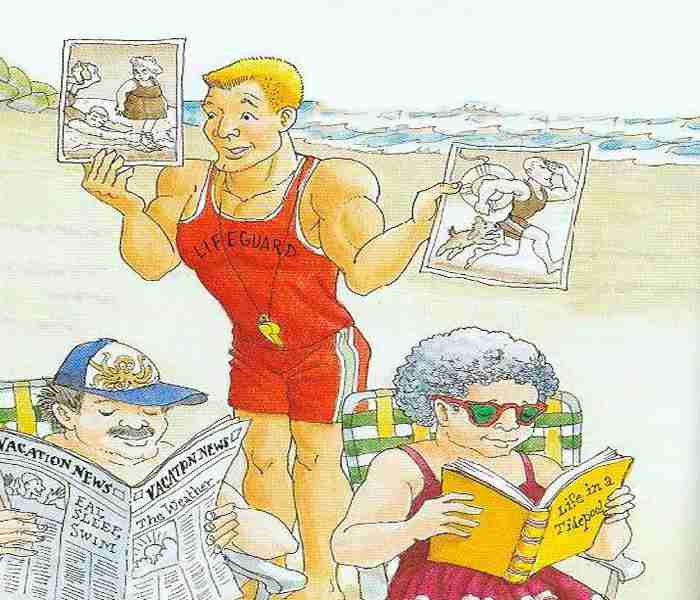
"We are now in the intertidal zone" said Ms. Frizzle.
"That is the part of shore that is covered with water at high tide, and uncovered at low tide."
Here I am saving a grandmother ... And this is my famous rescue of Muffy, a beloved family pet.
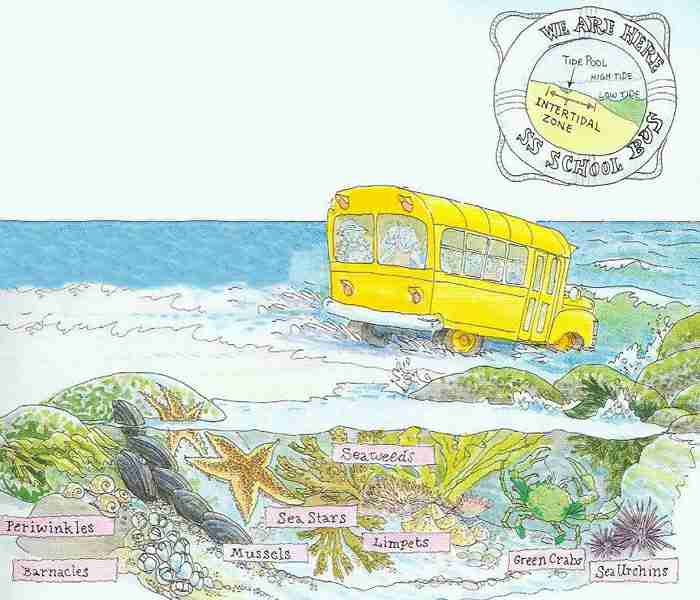
Out the windows we saw tide pools - puddles of water left on shore when the tide goes out.
We were hoping the Friz would let us out, but no such luck.
She kept driving full speed ahead.
She said we were going to the beach.
No, she didn't. She said we were going to the ocean. I guess she really meant it.
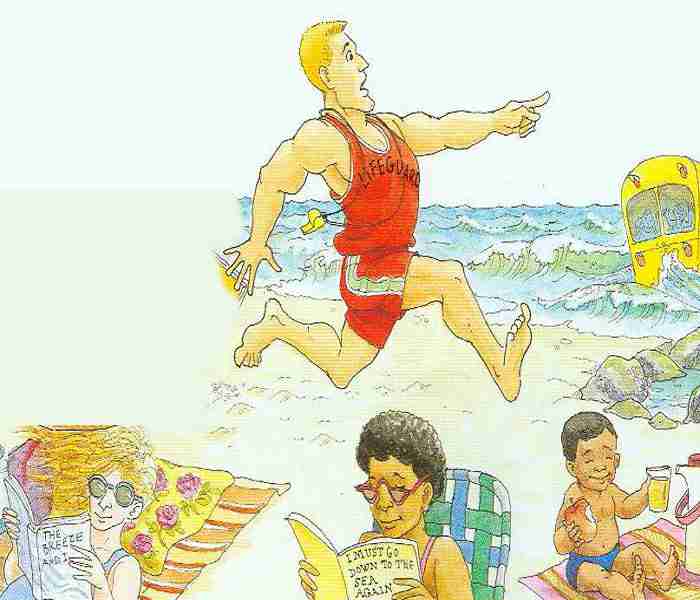
As the bus splashed through the waves, the lifeguard blew his whistle.
Frizzie didn't stop, so he came rushing out to rescue us.
Pardon me, please. I have to rescue a school bus.
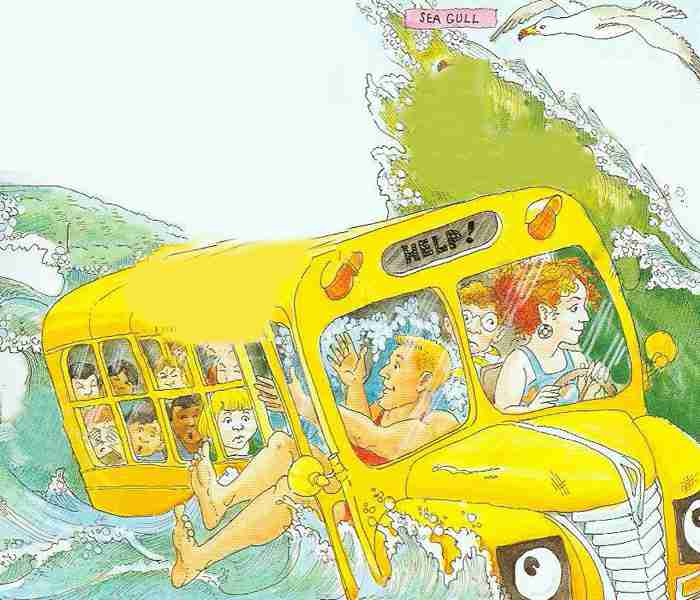
Suddenly in a mysterious wave rose up.
Ms. Frizzle opened the door of the bus and the lifeguard was swept inside.
Outside the windows we saw nothing but rushing water. We screamed and closed our eyes.We're going under! Hi. I'm Lenny the lifeguard. Oh great. I feel safer already.
Class, the best way to learn about the ocean is to see it close up. Not this close!
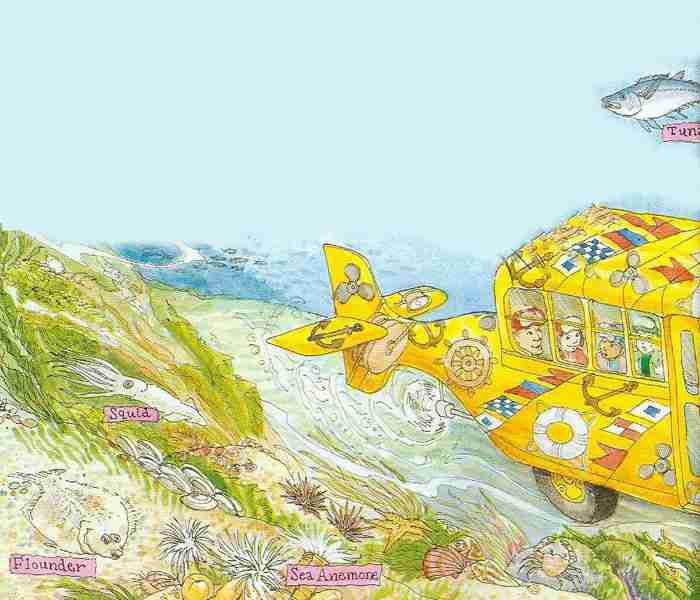
When we finally opened our eyes, everything was quiet.
We were under the ocean, and there had been a few small changes.
The bus had turned into a submarine, and everyone was wearing a diving suit.
We should have known. We were on another one of Ms. Frizzle's crazy class trips!
Don't worry kids, I'll save your lives. That's my Job.
Maybe later. Ms. Frizzle's just getting started. Nothing can stop her now.
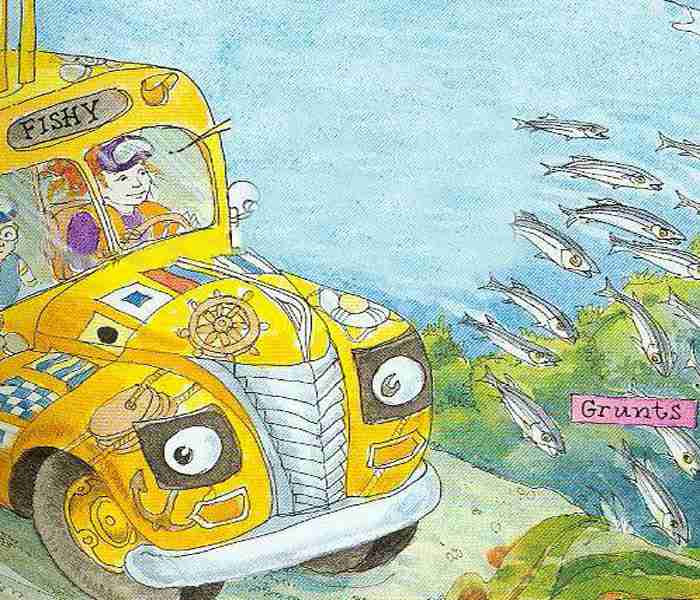
Right away, Ms. Frizzle started talking about the ocean.
"We are now passing over the continental shelf," she said.
"That's the area that stretches from the shore to where the water is four hundred to six hundred feet deep."
Class, the water is getting deeper and deeper. Ocean science is too deep for me!
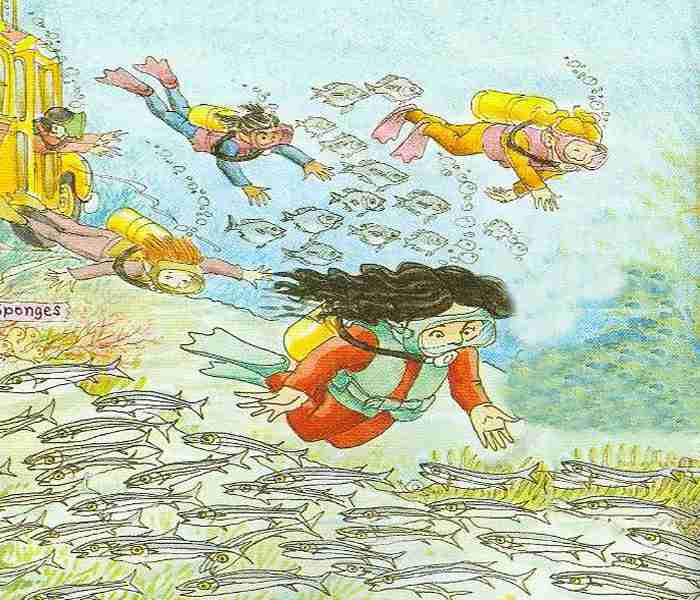
Ms. Frizzle decided this was a good moment for us to get out of the bus.
Thank goodness we had air tank! All around us were fish, fish, and more fish.
"Many kinds of fish swim in large groups called schools," said Ms. Frizzle.
Look! A school of fish! Look! A school of children! I wish we had a bus.
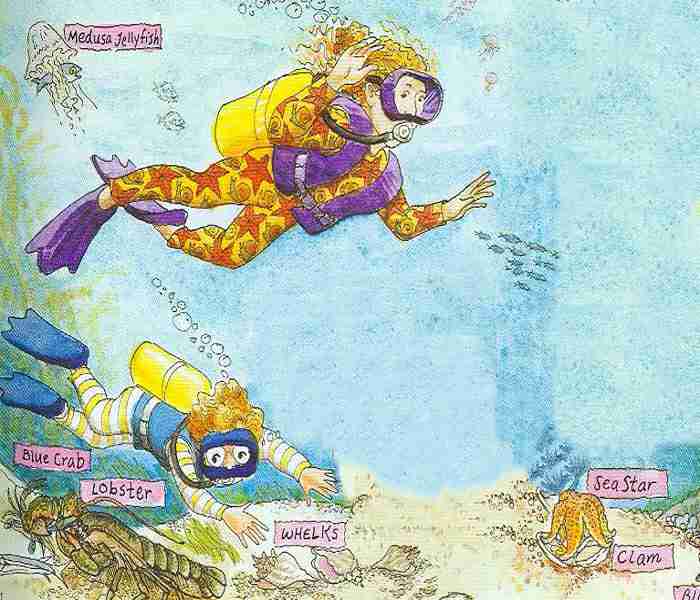
Down below, on the muddy bottom, lobsters were catching crabs.
Starfish used their arms to pry open clamshells.
And jellyfish floated past, catching small fish with their stinging tentacles.
The ocean was teeming with life!
Most of the seafood we eat comes from here on the continental shelf, Arnold.
I thought it came from the supermarket shelf.
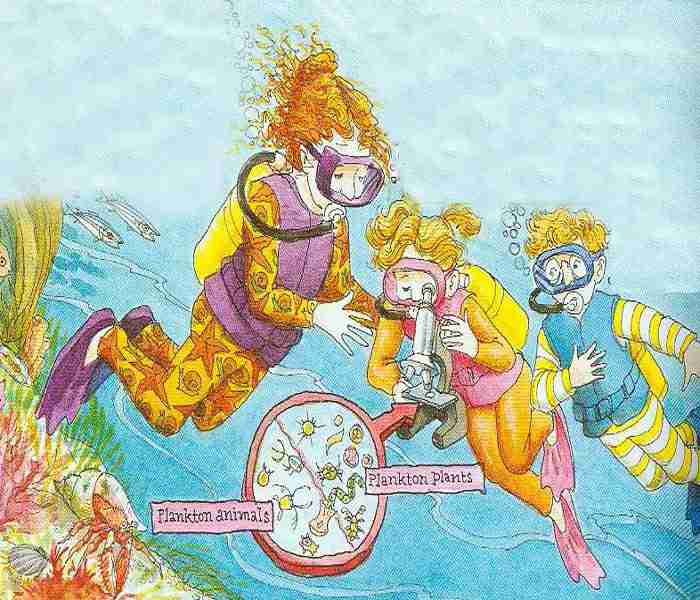
Ms. Frizzle said there was life in the water we couldn't even see.
She pulled out a microscope and made us look at seawater.
Under the microscope we saw strange creatures.
"Girls and boys," said Ms. Frizzle, "these tiny living things are called plankton."
There are two kinds of plankton, children. Some are plants and others are animals.
Wow! A plankton animal is eating a plankton plant. Oh, yummy.
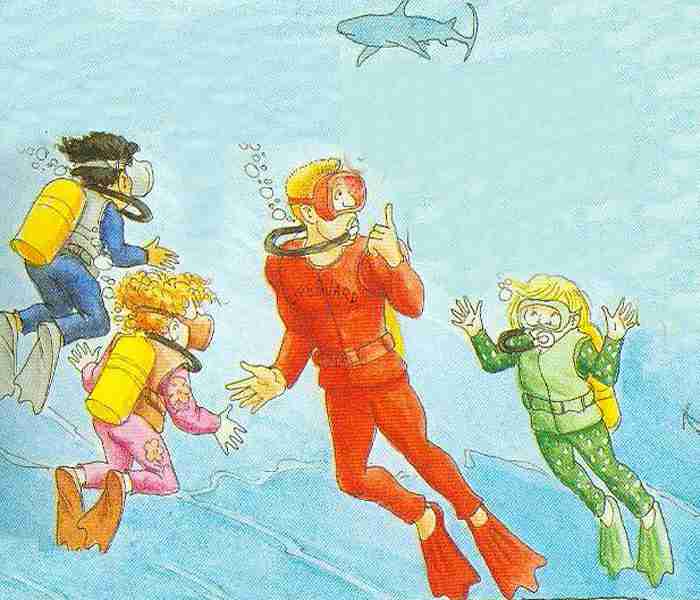
We tried to listen, but we felt nervous.
We noticed some dark shapes coming closer and closer.
Where have I seen that scary shape before? Does the word shark mean anything to you?
Oh no! Children should not be swimming in shark-infested waters. Thanks for the safety tip, Lenny.
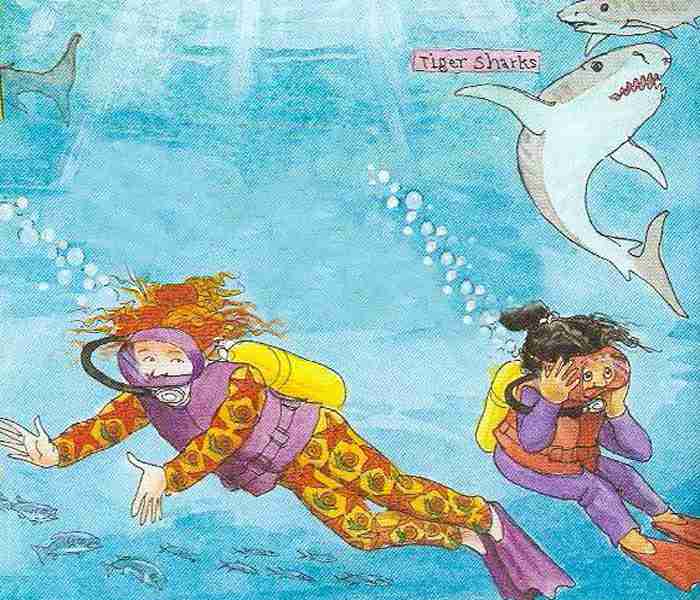
Oh, no! The shapes were tiger sharks! Ms. Frizzle told us not to worry.
She said most sharks will not eat people.
"The number of people killed by sharks every year is very, very small," said Ms. Frizzle.We panicked anyway!Humans are not the main diet of tiger sharksbut they may attack if humans are nearby. Uh-oh! We're nearby!
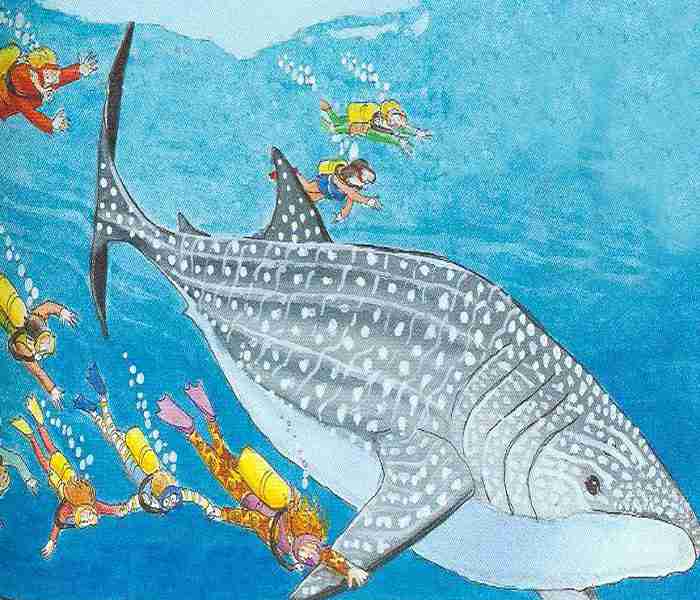
Then an enormous whale shark slid by.
"Whale sharks never hurt people. They eat nothing but plankton" said Ms. Frizzle.
The giant shark swam down, and we went along.
We were leaving the continental shelf, following a steep cliff called the continental slope.
We were on our way to the deep ocean floor.
Hey shark! Come back! I'm supposed to rescue the kids! Here we go!
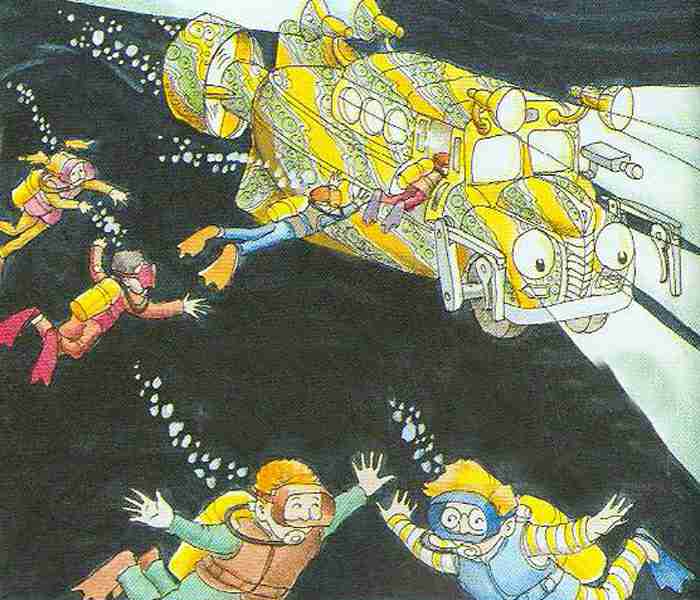
After a while, the whale shark swam away, but the Friz kept going down.
The water was bitter cold and pitch-dark.
Sunlight could not shine down so deep. Ms. Frizzle switched on her flashlight.
As we swam onto the bus, we noticed that it had changed again.
You're not afraid of the dark, are you, Arnold?
Who me? I love the dark. The dark is my friend. Can we go home now?

This time it was a submersible, a vehicle made for exploring the deep ocean floor.
"The pressure down here would crush an ordinary submarine,"
Frizzie explained, and she drove all the way to the bottom.
"There is not enough food here for large animals," Ms. Frizzle told us."Most deep-sea fish are tiny." The deep ocean floor was as empty as an underwater desert!
Those tiny deep-sea fish can glow in the dark.
They have their own special light, just as fireflies do on land.
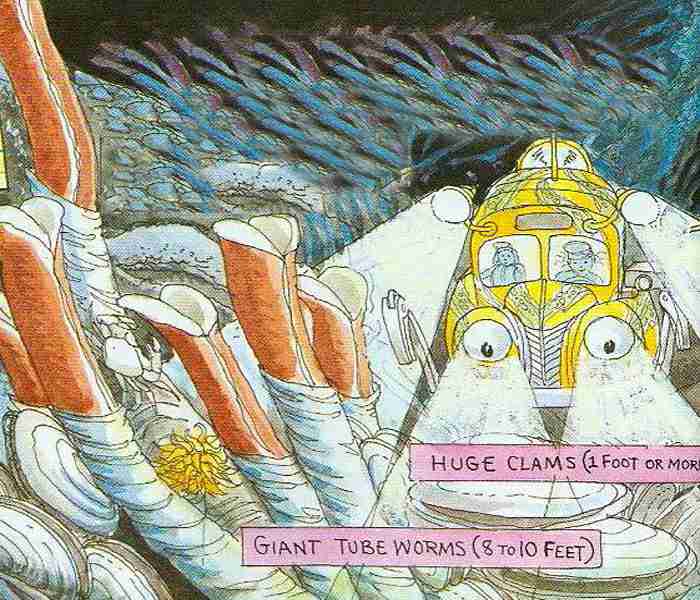
Then up ahead, we saw a spot that was full of life.It looked like an undersea garden with all kinds of strange animals in it.
"This is a hot-water vent, class," said the Friz. "A vent is an opening in the ocean floor.
Flowing from the vent is super-hot water mixed with hydrogen sulfide gas."
At a hot-water vent there is enough food for many large animals.
These tube worms look like huge lipsticks.
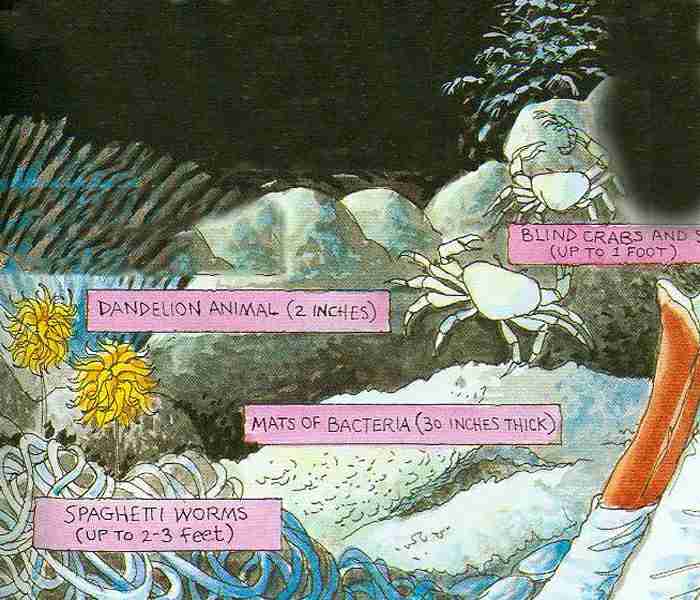
Ms. Frizzle said there were other vents on the ocean floor.
"Unfortunately, we don't have time to visit them," she added.
Then she pulled up a lever on the dashboard, and the bus zoomed toward the surface.
Those worms look just like spaghetti. Did we have Lunch?
Please. I just lost my appetite. That dandelion animal is like a little flower!
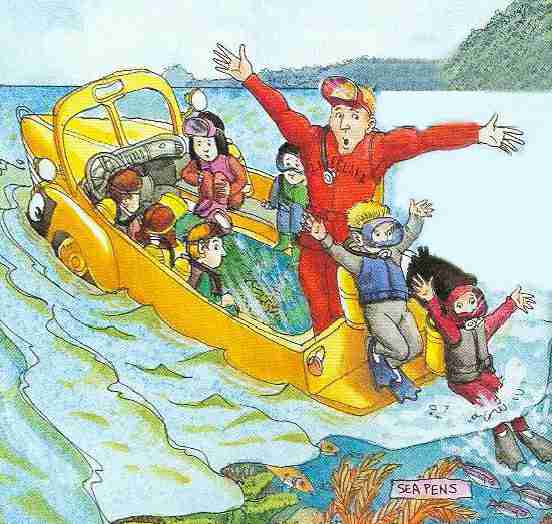
Soon we were motoring over the open ocean toward a sun-drenched island.
The bus had changed into a glass-bottom boat.
Through the glass, we saw what looked like a wall made of colorful rocks.
Ms. Frizzle said it was a coral reef, made of tiny animals called coral polyps.
We dove overboard and began to explore.
Don't swim far! I haven't finished saving you yet!
Oh, has he started already? I'm sure he's doing his best.
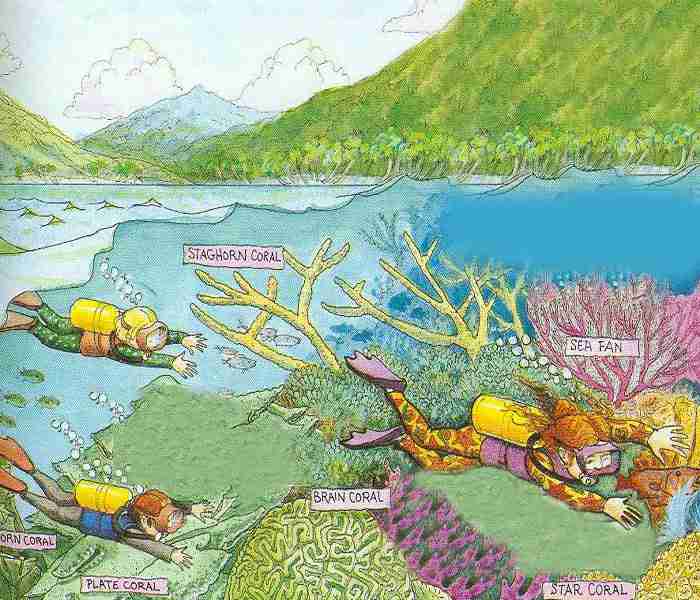
The reef was made of many different kinds of corals.
Some looked like trees with branches.
Others looked like fans or fingers. Some even looked like human brains!
Look! It's your brain! No, it's yours. I heard it's been missing for years.
Brain coral is not really a brain, children. It just happens to look like one.
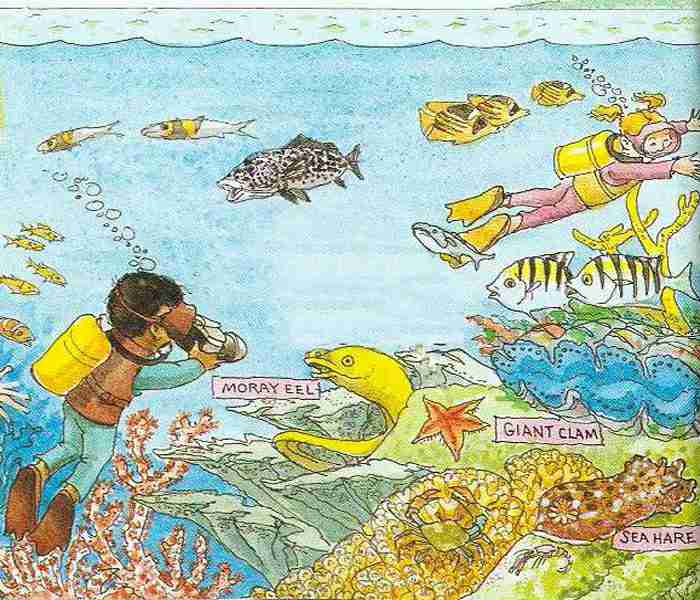
"A coral reef makes a good home for many ocean plants and animals," said the Friz.
We saw crabs and lobsters, huge eels and octopuses,slimy sea slugs and spiny sea urchins, and the most colorful fish in the world.
Smile everyone! I always knew I was a star.
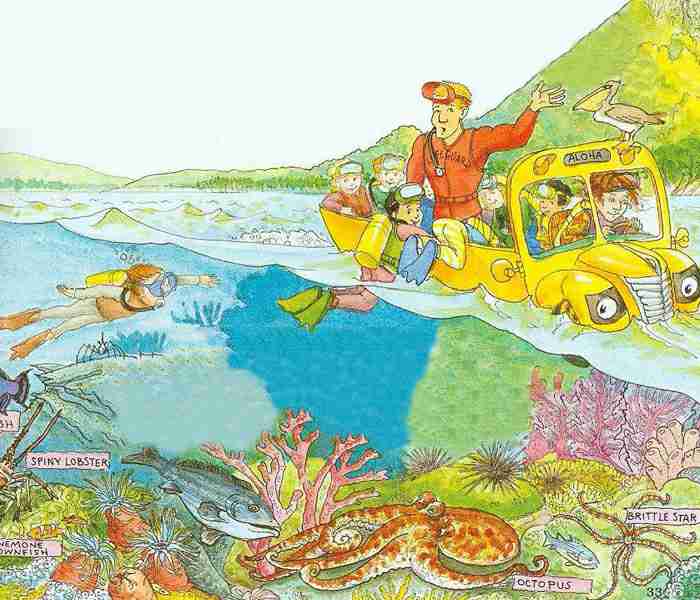
Too soon, Ms. Frizzle said it was time to go.
No one wanted to be left behind so we all climbed aboard.
Frizzie stepped on the gas, and the bus chugged away from the coral reef.
Don't worry kids. We'll soon be home. Which way is home?
Today, many coral reefs are in danger. People can help save them.
It took thousands of years to build this reef.
Please don't break it ... Or pollute it. Be careful of our home!
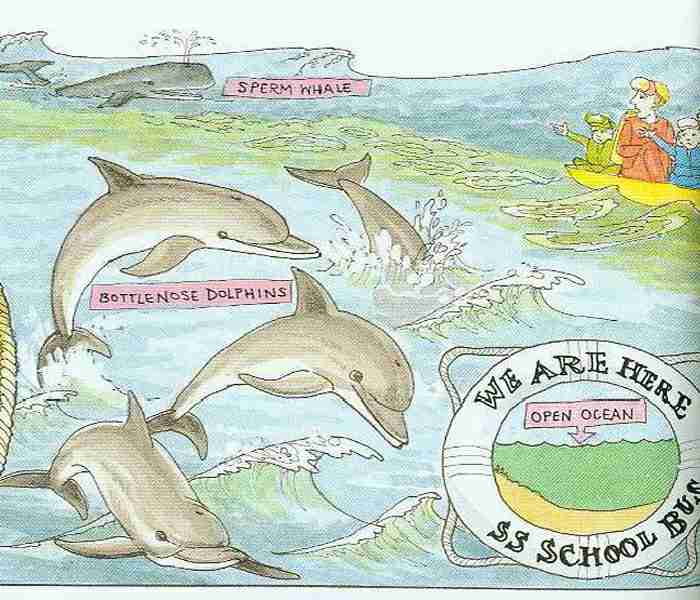
Nearby, a school of dolphins leaped past.
In the distance, we saw a whale. Everything seemed normal.
Then we noticed that something weird was happening. The bus was getting flat.
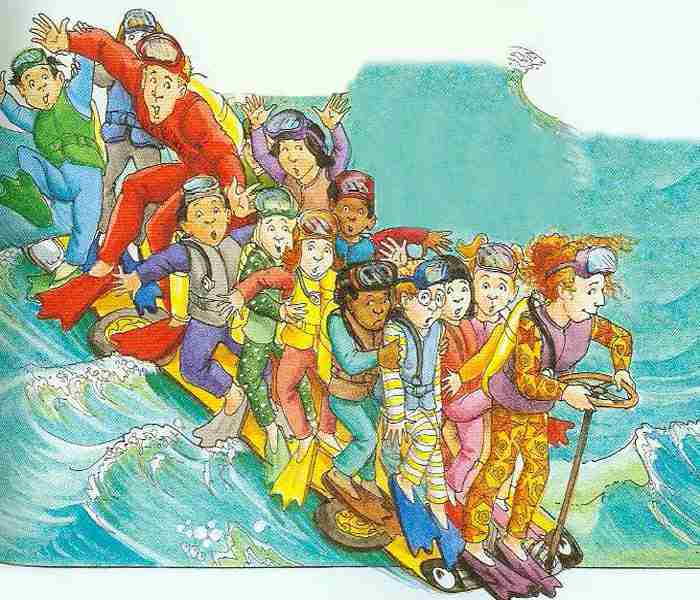
As usual, Ms. Frizzle was the only one who stayed calm.
She drove us to an ocean current,and we were swept along in the fast-moving water for thousands of miles.
After a while, we saw our beach again.
Tell me, kids, is your bus always like this? Well it's never been a boat before ...
And it's never been flat before ... But otherwise it hasn't changed. Keep your balance class.
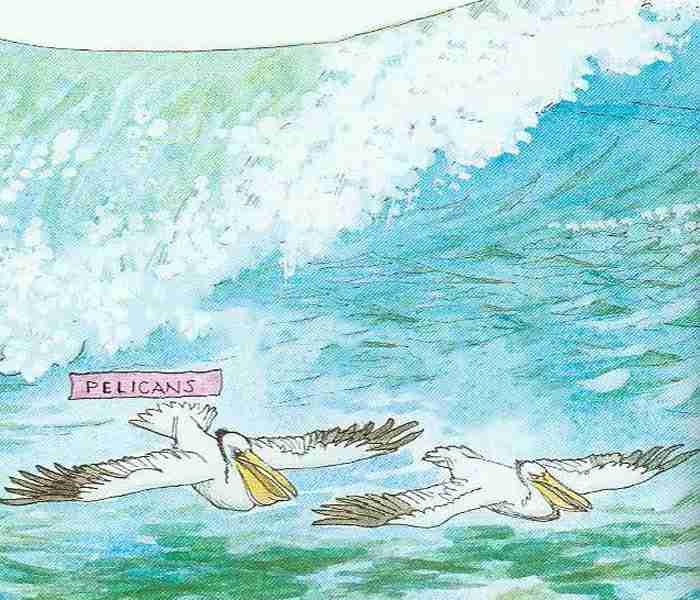
"Everyone stay on the bus!" shouted the Friz.
On the bus was right. It had turned into a giant surfboard!
This is the greatest rescue of my career. Congratulations, Lenny! We knew you could do it!
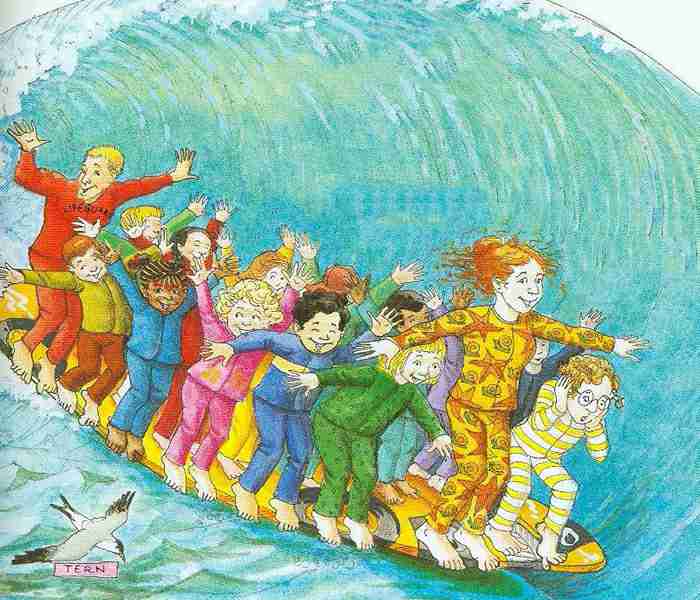
We had to stand on top of it. And we were riding a wild wave straight toward shore!
Hooray! We're surfing! Cowabunga! Hang ten, class! Could I just hang one?
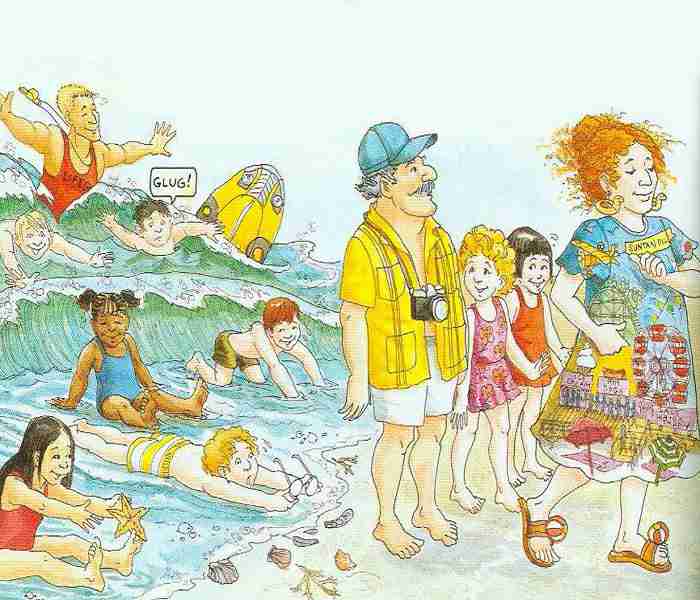
Oh, no! It was a giant wipeout! The whole class went under.
The next thing we knew, we were washing up on the sand.
Thanks to me you're safe now children.Glug! Tell me, does your teacher always dress like that?
Not always ... Sometimes she looks totally outrageous.
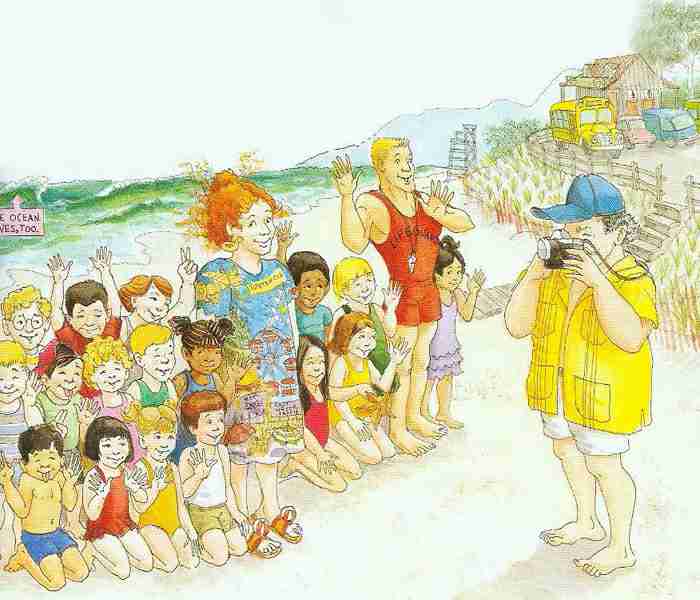
Our diving suits were gone, and the bus was its old self again.There it was, sitting in the parking lot as if nothing had happened.We thanked Lenny for everything and hit the road.
Could you take a picture, please? I've never saved a whole class before.
Okay, everybody. Smile and wave.
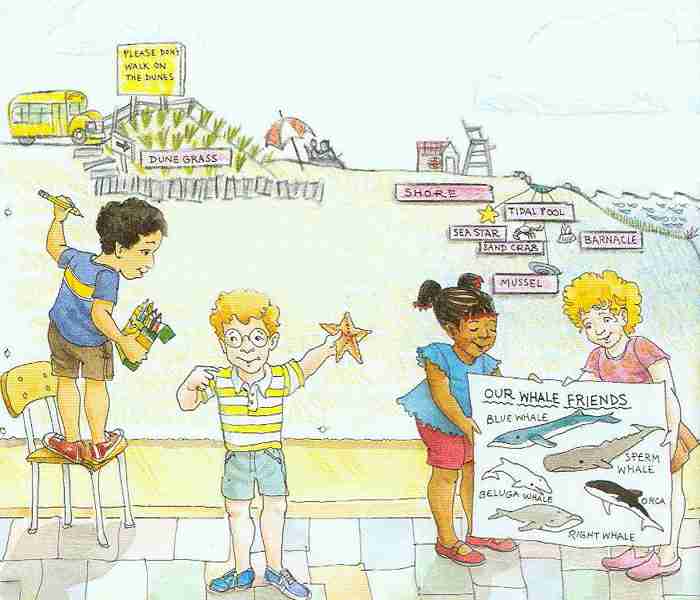
Back in our classroom, we made a terrific chart of the ocean for the bulletin board.
Hey, Arnold, wasn't that surfboard great? I like bulletin boards myself.
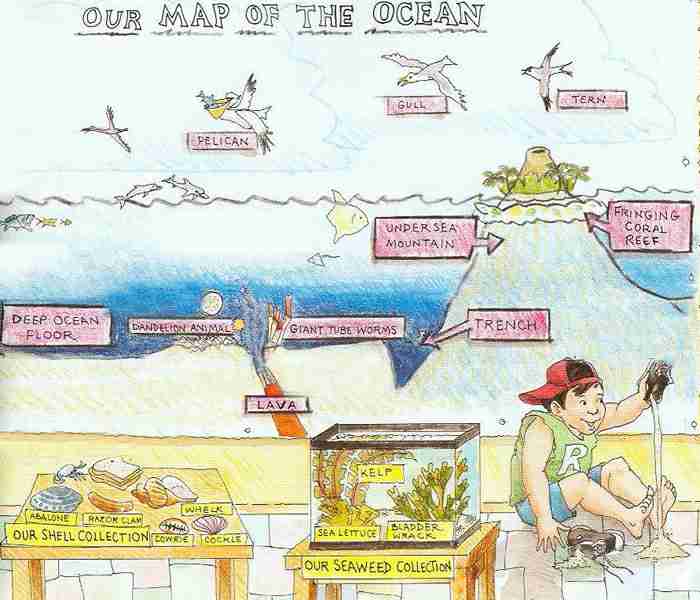
Hey, I've got a sand collection!
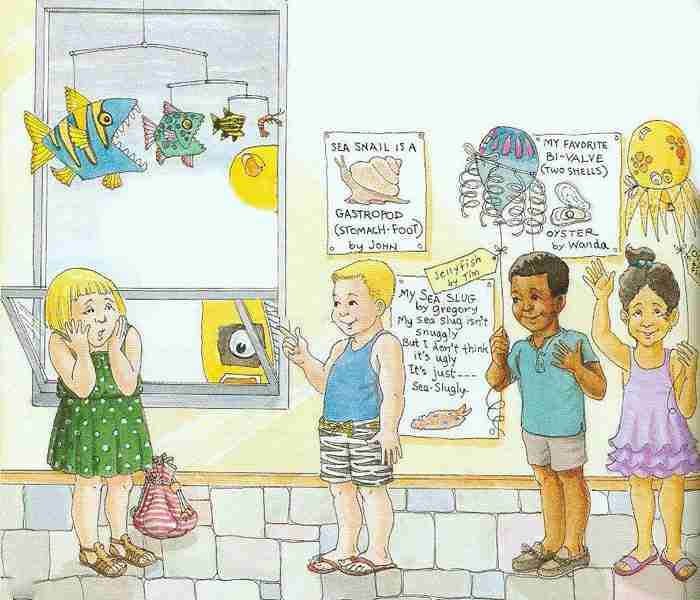
By then we were definitely ready to go home. Thank goodness it was Friday!
After that class trip we really needed a weekend off!
I'm exhausted ... and my Dad's taking me to the beach tomorrow.
Don't worry, it's supposed to rain. Whew!
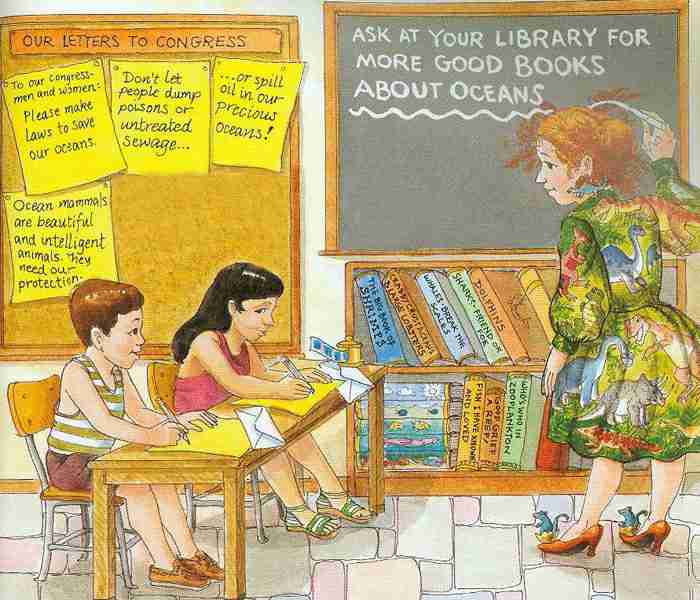
Uh-oh. Look at her dress. Don't worry. Dinosaurs aren't around anymore.
Class, I am going to read all your wonderful reports.
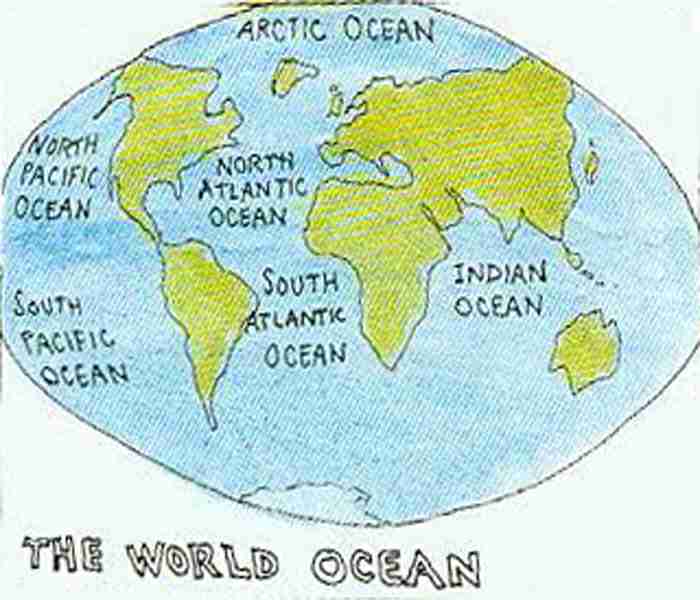
We'll start with all the oceans of the world are really one huge ocean! By Rachel
The oceans of the world are all connected. Together they form one world ocean.
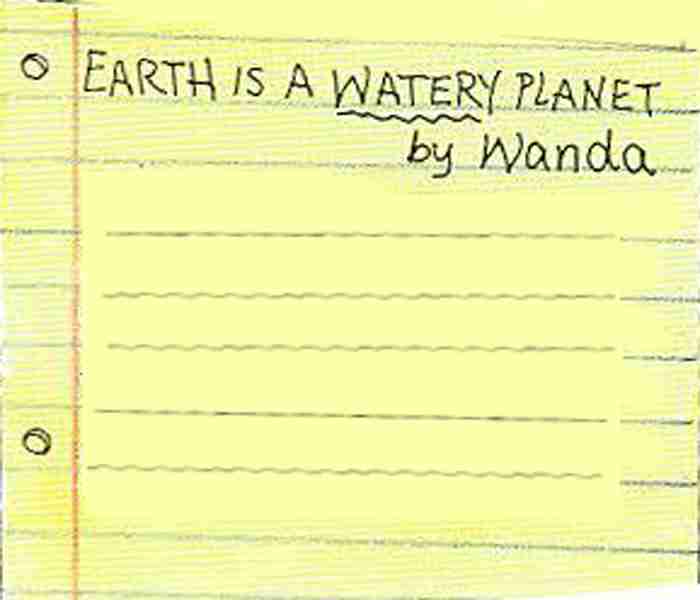
And below earth is a watery planet by Wanda
There is more water than land on earth. Oceans cover almost three-fourths of the planet!
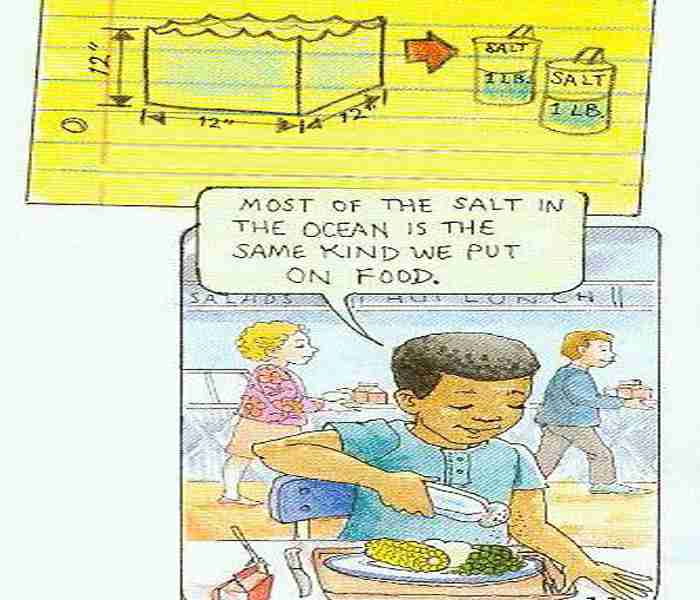
Why is the ocean salty? by Tim.
Much of the salt in the ocean water comes from rocks.Rocks have salt in them. When rocks are worn down by water, the salt goes into the water.
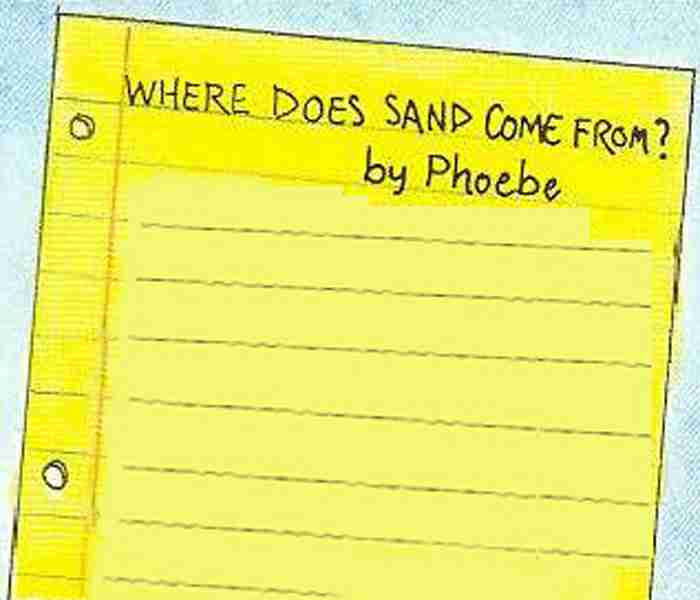
Where does sand come from? by phoebe
Sand is formed when rocks break apart and crumble into bits.Each grain of sand is really a tiny piece of rock or shell.
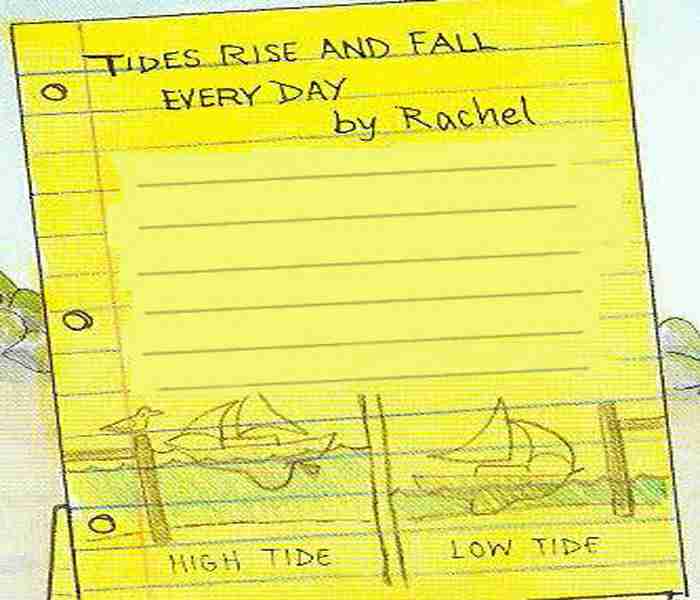
Tides rise and fall every day by Rachel
When the water near shore rises and gets deep, it is high tide.When the waterfalls and gets shallow, it is low tide.
Tides are caused mostly by the pull of the moon's gravity on the earth and its oceans.
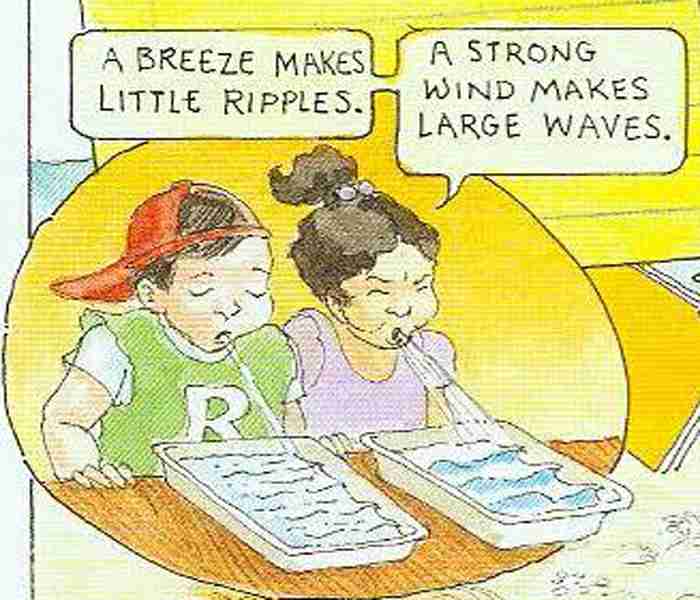
What makes waves? by Florrie
Most of the waves we see are caused by wind. The stronger the wind, the bigger the waves.
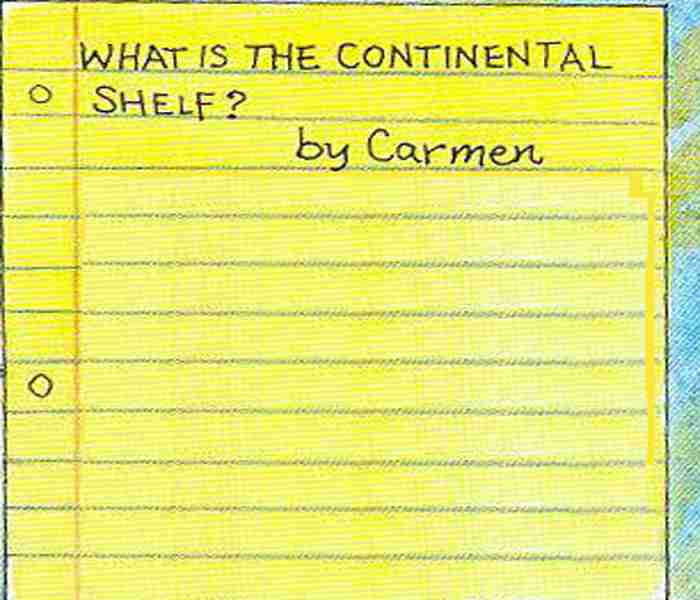
What is the continental shelf? by Carmen
All around the edge of the world's continents, the land slants down and is covered by ocean water.This underwater land is called the continental shelf.
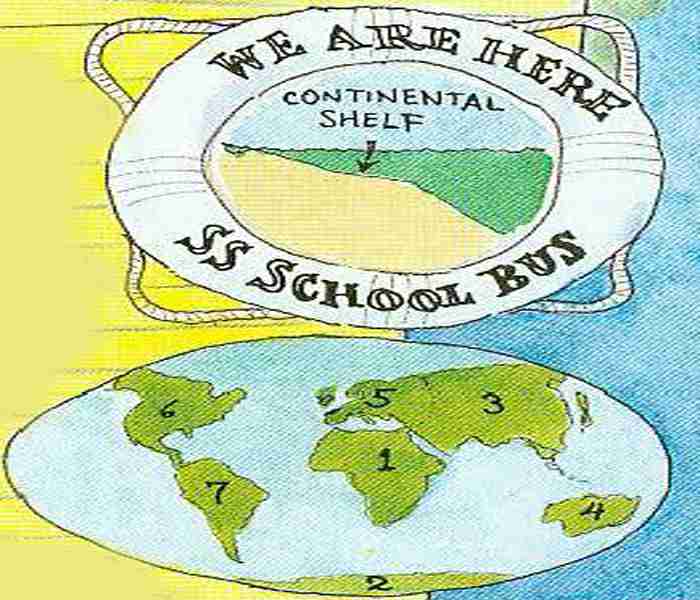
A new word by Dorothy Ann
A continent is one of the seven main masses of land on the earth.Africa and Antarctica; Asia; Australia; Europe; North America and South America
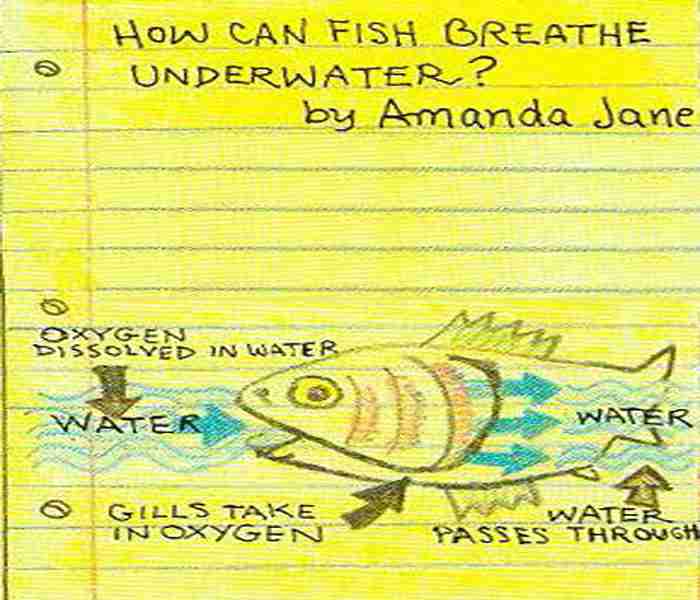
How can fish breathe underwater? by Amanda Jane
People have lungs that take oxygen from air. Fish have gills that can take oxygen from water.
Water flows into the fish's mouth, then the gills, and out through slits in the fish's sides.
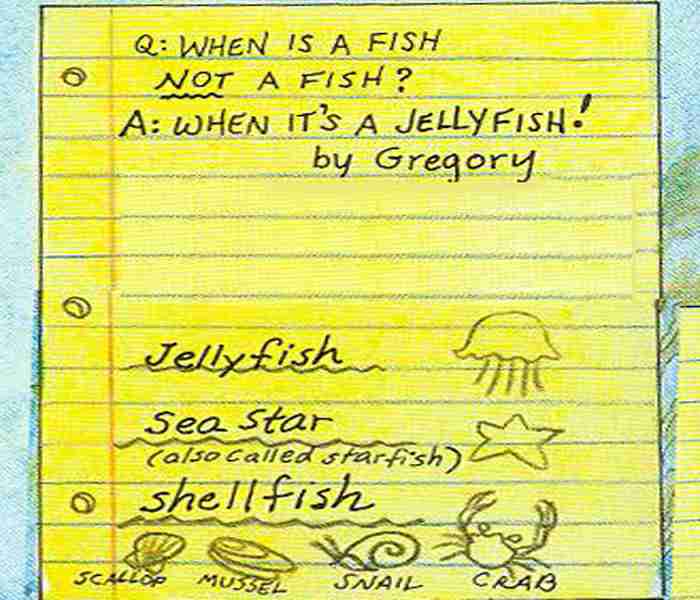
Question: when is a fish not a fish?
Answer: When it's a Jellyfish! by Gregory
A true fish has a backbone, gills and fins. Some animals are called "fish" but they are not.Actually, they are invertebrates, animals without backbones.Here are some of them: Jellyfish;Sea star (also called starfish) and Shellfish; Scallop; Mussel; Snail and Crab
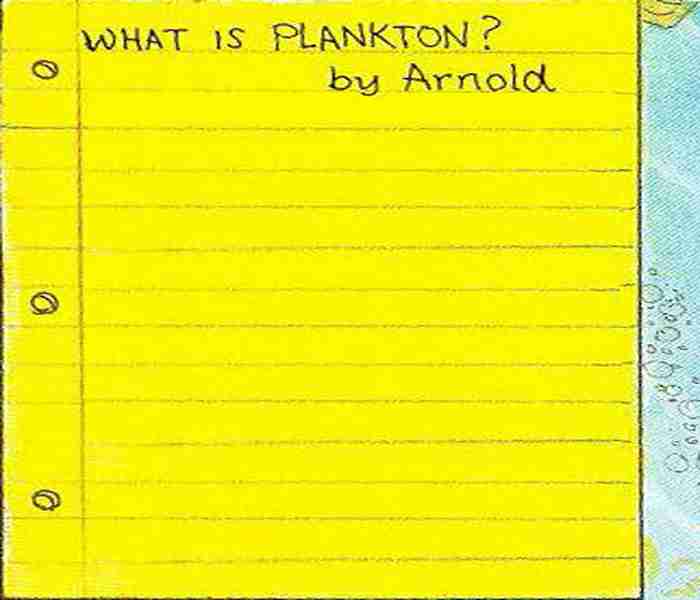
What is plankton? By Arnold
Plankton is a mass of plants and animals that float near the surface of the ocean.Most plankton are very small. Many cannot be seen without a microscope.
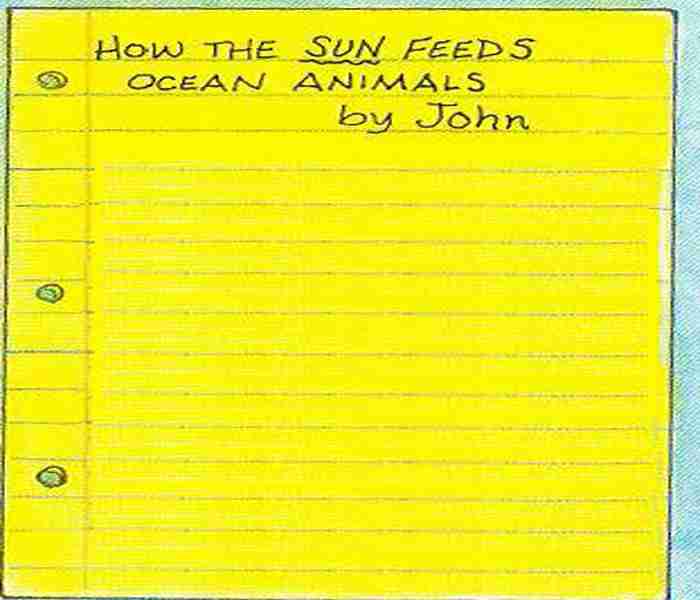
How the sun feeds ocean animals by John
Plankton plants make food by using energy from the sun.Plankton animals eat the plankton plants.Larger animals eat the plankton animals. This is called a food chain.Without the sun shining on plankton plants most ocean animals could not exist.
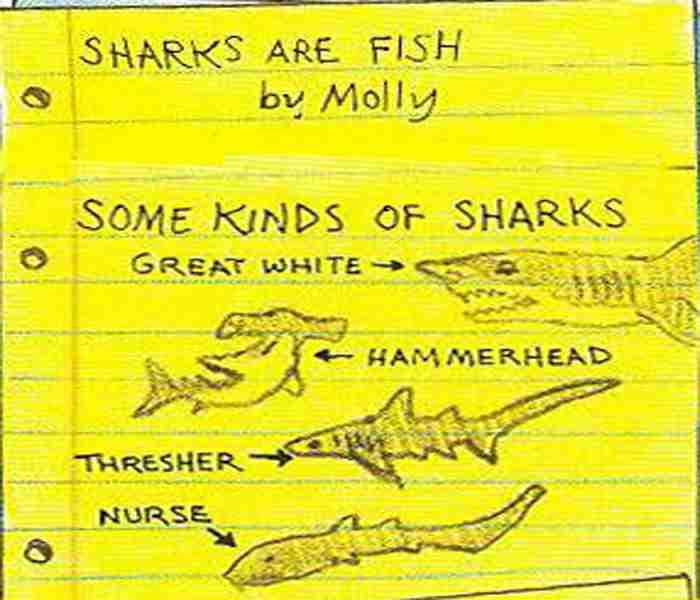
Sharks are fish by Molly.
Most sharks are fast swimmers with razor-sharp teeth.Usually they eat ocean animals like crabs, fish, seals-even other sharks.Some kinds of sharks great white; Hammerhead; Thresher and Nurse
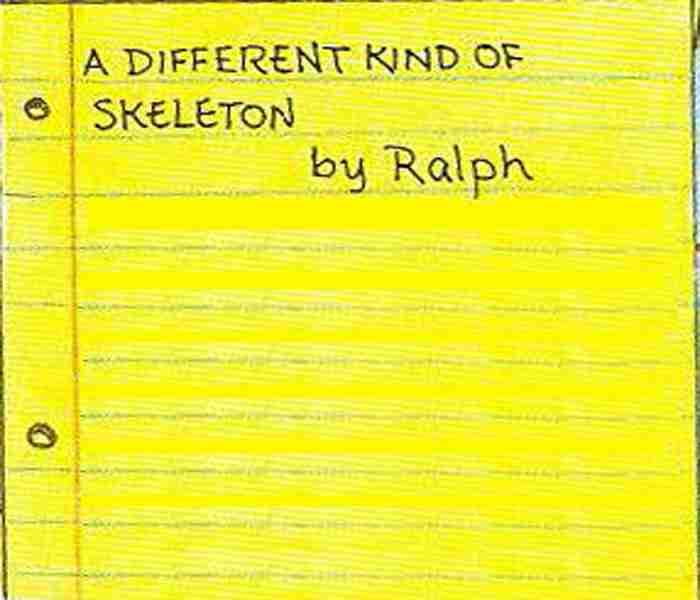
A different kind of skeleton by Ralph
Sharks do not have bones like other fish. Their skeleton is made of cartilage.This is the same bendable material that is in your ears and the tip of your nose.
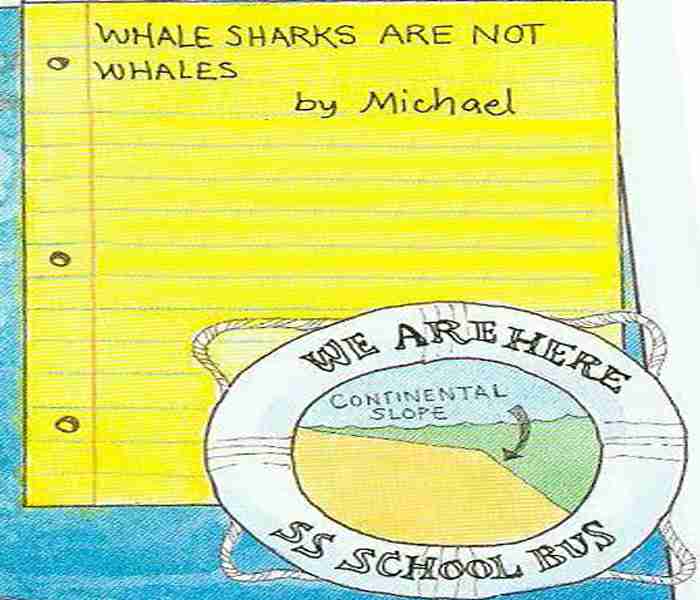
Whale sharks are not whales by Michael.
Whale sharks are fish like other sharks.They were named after whales because they are the biggest of all sharks.
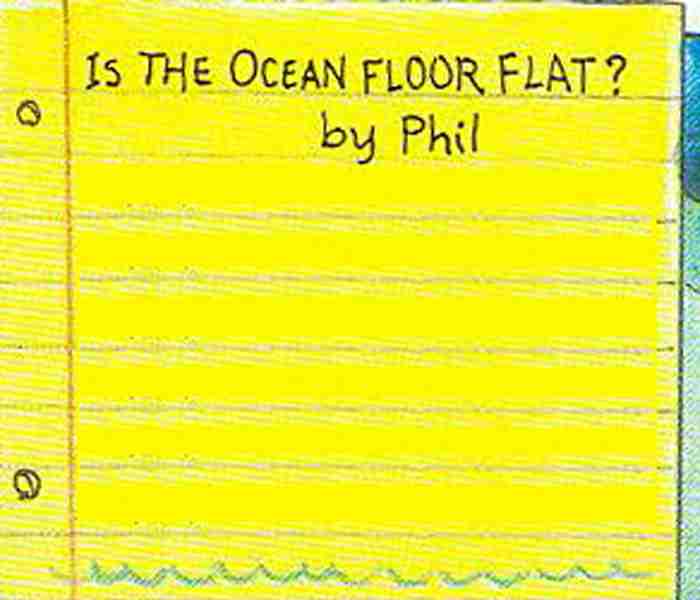
Is the ocean floor flat? by Phil
Flat plains cover much of the ocean floor, but not all of it.The deepest valleys and topless mountains on earth are found under the ocean.An underwater valley is called a trench. The deepest trench yet found is 7 miles down.
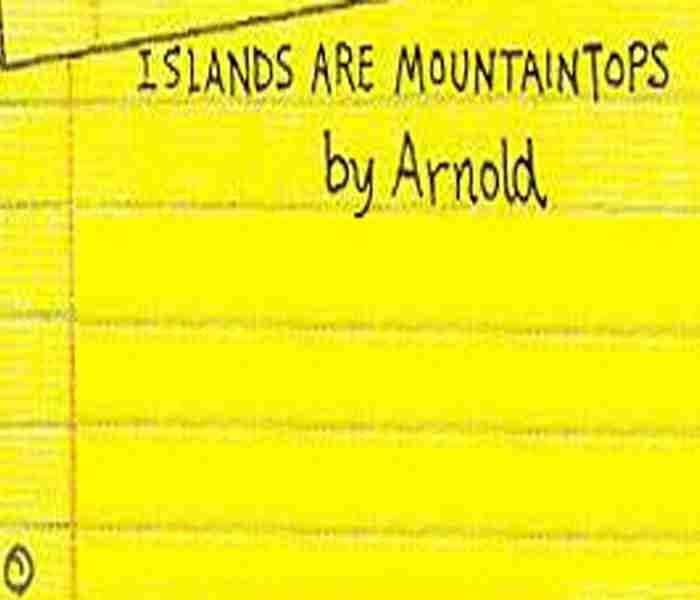
Islands are mountaintops by ArnoldWhen the top of an undersea mountain is above the surface, it is called an island.
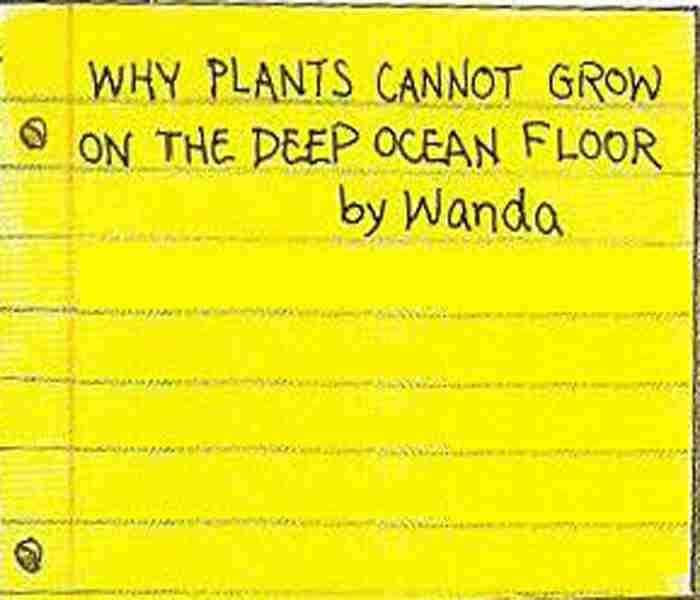
Why plants cannot grow on the deep ocean floor by Wanda
Plants need light to grow. It is too dark for plant life on the ocean bottom.
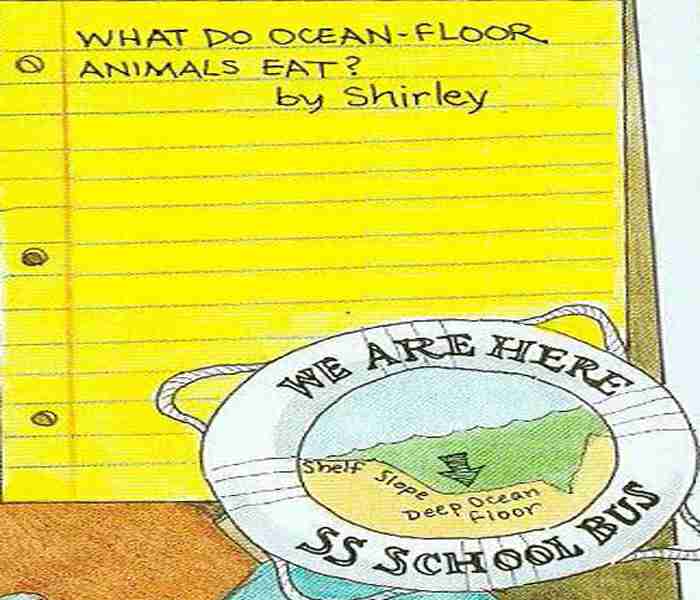
What do ocean-floor animal eat by Shirley
Some deep-sea animals depend on bits of food that sink from the upper ocean.Others use their special lights to attract prey.
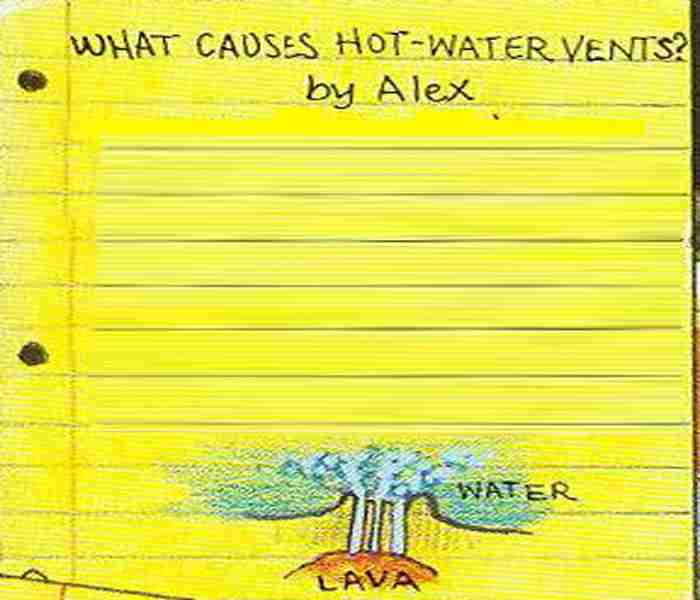
What causes hot-water vents? by Alex
A vent is formed when seawater seeps into cracks in the ocean floor.The water touches super-hot rock inside the earth.Then the hot water shoots up out of the vent.

How food is made at a vent by Shirley
Special bacteria manufacture their own food using heat energy and hydrogen sulfide gas from the vent.This food supports much of the life at the vent.
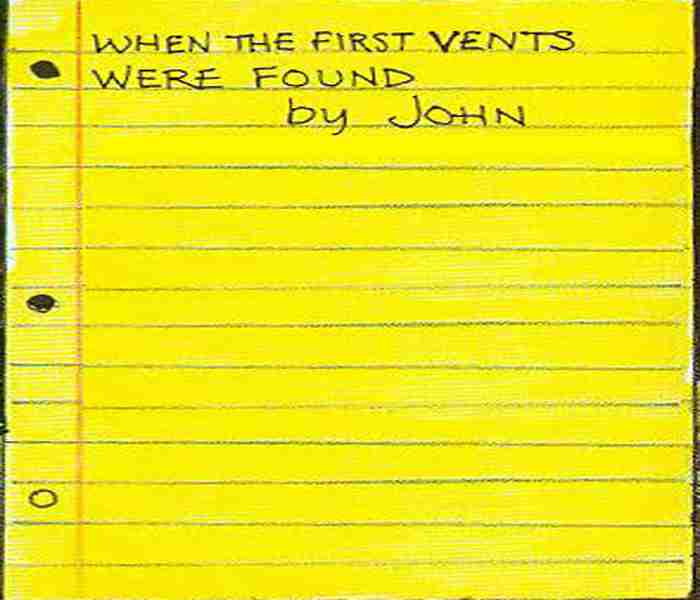
When the first vents were found by John
The first vents were discovered in the 1970's and 1980's.Before then, ocean scientists had never seen large animals like these on the deep ocean floor.
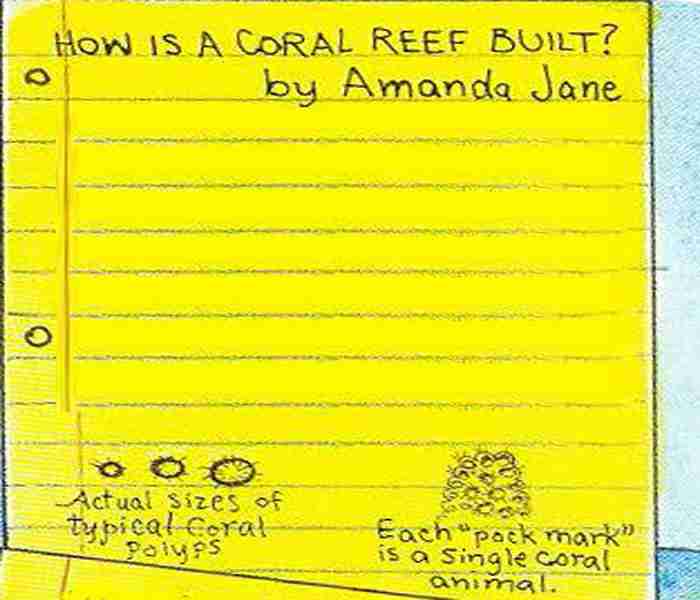
How is a coral reef built? by Amanda JaneEach coral polyp grows a stony skeleton around itself.The reef is made of a layer of living coral animalsattached to a wall of many millions of dead skeletons.
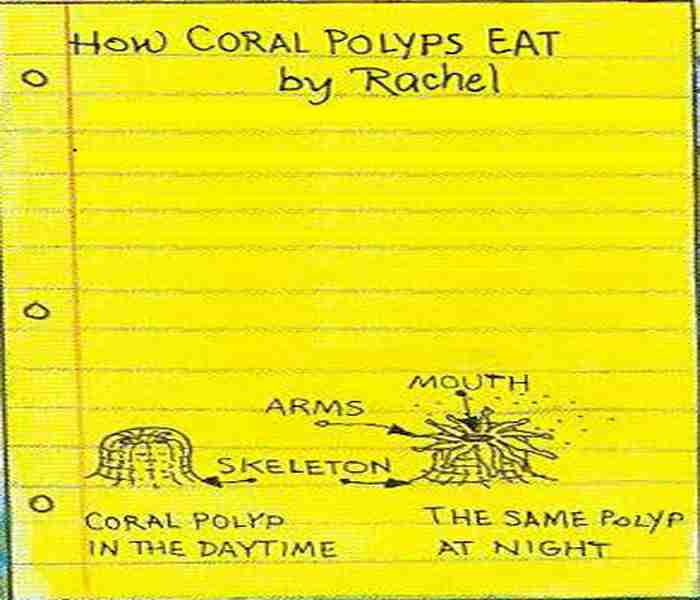
How coral polyps eat by Rachel. Most corals feed at night.Tiny arms come out of a coral's stony skeleton.The arms catch plankton and pass it into the coral's mouth.
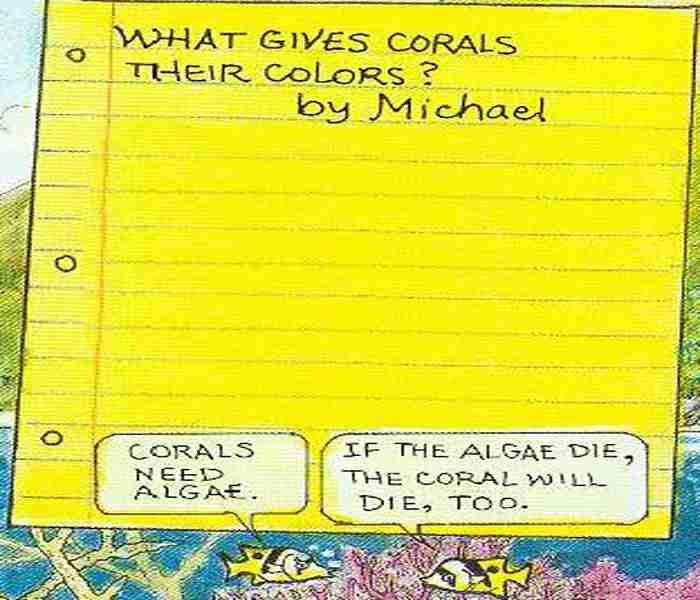
What gives corals their colors? by Michael
Colorful one-celled plants called algae live inside coral polyps.The algae give the coral its color. Without algae, all coral is plain white.
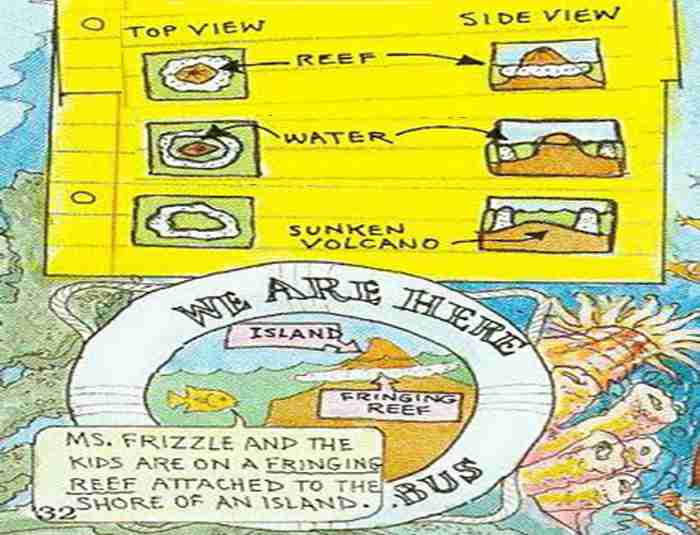
Three kinds of coral reefs by Tim.A fringing reef is attached to the shore.A barrier reef has a channel of water between it and the shore.And an atoll is a ring of coral around a sunken volcano.
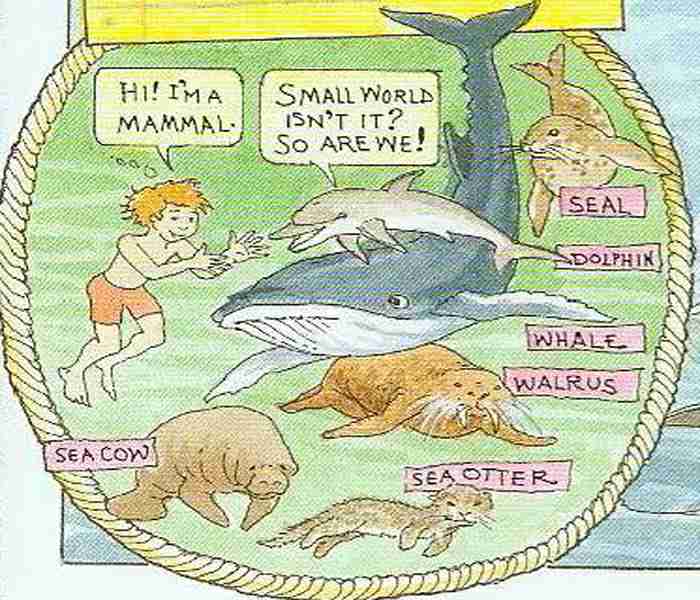
Mammals in the sea by FlorrieAnimals such as dolphins, whales, seals and walruses are not fish.They are warm-blooded mammals like horses, dogs and human beings.
Most fish lay eggs but mammals do not.Mother mammals give birth to live young and feed their babies with milk.
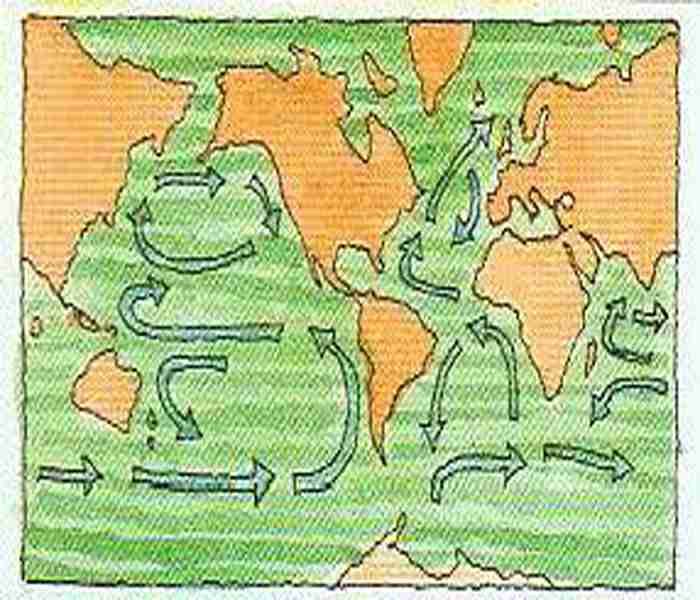
Rivers in the ocean by Phoebe.
Parts of the ocean flow like rivers. These moving areas are called ocean currents.

Why do big waves "break" near shore? by Carmen.
In shallow water, the ocean bottom drags on the lower part of the wave and slows it down.The upper part keeps going fast, so it falls over, or breaks.

